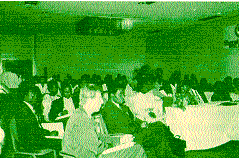Smithsonian Institution Man and Biosphere
Program Trains Four Members in Biodiversity Measuring
and Monitoring
Edward Mgbang and Bernard Nwokocha
Four members of Bloresources
Development and Conservation Programme attended the 1996
Biodiversity Measuring and Monitoring: In-residence Certification
Training Course organized by the Smithsonian Institution/
Man & the Biosphere Biodiversity Programs, held on May
12-June 14 in Front Royal, Virginia, USA. The course has
the objectives of reinforcing the participants knowledge
of the interactions among organisms and ecosystems and
to link them to a strong professional network, facilitating
future collaborations as well as offering participants
the opportunity to learn skills that can be applied to
different situations. This course involved an overview
of methodologies and procedures that are currently in
use for measuring and monitoring blodiversity. Ablotic
factors, bacteria and microor(,anisms, vegetation, bird
populations and communities, amphibians and reptile, invertebrate
populations, fresh water fishes and aquatic invertebrates
were measured and monitored during the course. The course
ended with an integration of the different methodologies
that were employed during the course, using the Canadian
Biodiversity model as a case study.
Twenty one participants
attended and actively participated in all course activities.
Each participant gave a talk of his/ her biodiversity
project or current work experience at his/her home country.
At the end of each presentation, there was a question,,
and answer section. This provided an opport unity for
interaction and exchange of ideas between participants.
It made participants identify each other's interest and
in most cases the similarities of their different endeavors.
An avenue for closer ties and future collaboration was
therefore opened to participants.
The SI/MAB training
course created opportunity for participants to design
and carry out sampling and monitoring protocols for multiple
taxa. Participants have also acquired a fountain of knowledge
that could be applied to their individual problems in
biodiversity monitoring. The involvement of participants
and instructors with different backgrounds, experiences
and from different -eographlcal regions in the course
has provided an increased access to professional networks,
dissemination of results, ability to compare results,
awareness of funding sources and the effectiveness and
flexibil ity
in measuring and monitoring biodiversity. ity
in measuring and monitoring biodiversity.
This training has
equipped participants to set similar programs and teach
others with a view to establishing a team of experts thus
strengthening the global network. Subsequently, BDCP and
Smithsonian Institution Man and Biosphere Program are
organizing a trainin(y program in biodiversity measuring
and monitoring to be held in November, 1996 and February,
1997 in Cameroon and Nigeria respectively. This is a prelude
to the actual establishment of a network of biodiversity
measuring and monitoring plots to be established in both
countries as part of the International Cooperative Biodiversity
Group project on Drug Development and Conservation of
Biodiversity in West and Central Africa.
Biological Resources
is published monthly by The Bioresources Development and
Conservation Programme. The information contained here
is intended to contribute to the development of an integrated
approach to biological resources management in which human
needs and habitat conservation can both be accomodated.
Your comments and questions
are welcome. Write to the Editor, Biological Resources.
For further information, contact:
BDCP Newsletter Bureau
Bioresources Development and Conservation Programme
11303 Amherst Avenue, Suite 2
Silver Spring, Maryland 20902
U.S.A.
Phone: 301-962-6201
Fax: 301-962-6205
Email: bdcp@bioresources.org
Administrative
Offices
|